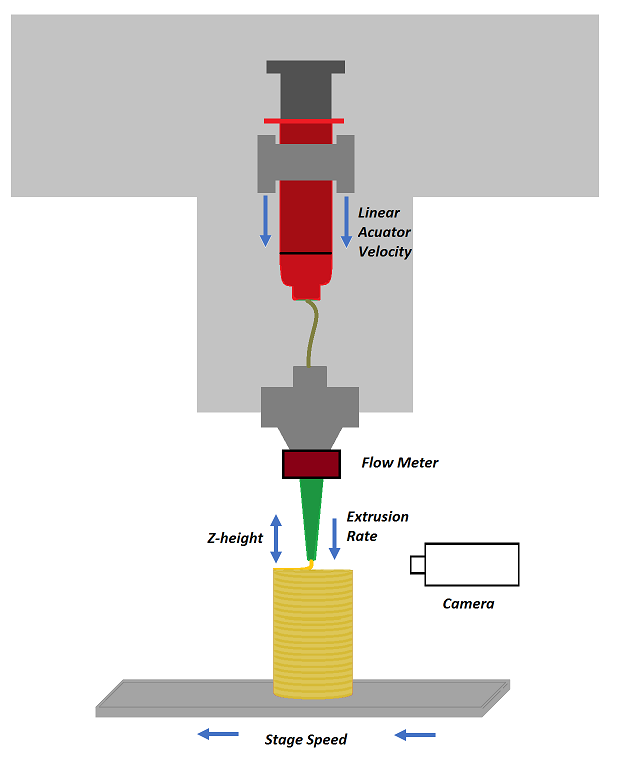Extrusion-based printing processes can be subdivided into direct-ink writing (DIW) and fused-deposition modeling (FDM). Both extrusion processes are additive-manufacturing methods that allow for customizable materials to be 3D printed into arbitrarily shaped parts. DIW printing exploits the rheological properties of shearing-thinning fluids that exhibit a yield stress by extruding a material as a liquid, which subsequently solidifies once shear forces are no longer applied. The state-of-the-art embodiment of a DIW system uses a computer-controlled translation stage that moves relative to a nozzle allowing for predetermined paths of the ink to be deposited onto the build platform. FDM printing is a similar method that exploits the melting point of thermoplastics to produce a shear-thinning fluid that can be extruded from a nozzle and subsequently solidified once cooled to the ambient temperature.
Although many materials can be developed into inks and filaments that fit the specifications required for extrusion-based printing, the variation in ink preparation and the resulting complex rheological properties make precision fluid control difficult to manage. Frequent starts and stops in fluid flow are often required for optimal tool paths but are difficult to achieve due to varying capacitance or response times for different materials. Over or under extrusion relative to the speed of the translational stage will cause irregular filament sizes and produce varying defects throughout a given print. Moreover, disturbances such air bubbles and clogs are catastrophic to the printing process as they introduce voids to the part or completely halt the printing process all together. Potential for these defects can be addressed through in-situ monitoring and feedback/feedforward control. By manipulating the extrusion rate, stage speed and z-height (distance between the nozzle and substrate), the quality of the filament dispensed during the build can be controlled.
Previous methods employed to combat these issues involve a conventional proportional-integral-derivative (PID) servo loop for extrusion control. Extrusion actuation is generated by a ball screw servo motor and the feedback loop takes voltage or current as the control input and linear displacement of the ink within the reservoir as the control output. More sophisticated research has been performed by implementing an on-off (or "bang-bang") controller(s) or modeling DIW system dynamics and implementing predictive algorithms (e.g., model predictive control) to control extrusion rate or to abort printing altogether. Although these methods significantly improve the extrusion process, the user is still required to manually determine printing parameters (i.e., stage speed, extrusion rate, and z-height) and monitor for air bubbles or clogs. This requirement for human involvement severely limits the scalability of extrusion-based printing processes. Additionally, the controller is decoupled from the quality of the extruded filaments and is not part of the control loop.
Livermore researchers have developed a method for implementing closed-loop control in extrusion printing processes by means of novel sensing, machine learning, and optimal control algorithms for the optimization of printing parameters and controllability. The system includes a suite of sensors, including cameras, voltage and current meters, scales, etc., that provide in-situ process monitoring and an online optimizer for determining ideal process parameters throughout a given print. Computer vision and machine learning are used in the process to monitor and derive quantitative values describing filament quality, e.g. eccentricity, continuity of a filament, color as it relates to mixing quality, among other possible metrics. These process data are passed through a dynamic model of the system to obtain estimates of essential state variables. An optimal controller uses this feedback to obtain the relationship between control inputs and control outputs to calculate future regulatory moves for overall precision printing.
Figure 1: Overall schematic of a direct-ink-write printer with in-situ sensing.
Figure 2: Cross sections of dispensed filaments that exhibited different rheological properties. Depending on the material and desired shape, the controller minimizes the error between the desired cross-sectional shape and the measured value from the camera.
This technology includes optimal printing parameters and filament quality in the control loop to produce higher quality prints. This system can enable real-time monitoring and control that is necessary for long production runs without human intervention. Also, the system will allow rapid development of new printing materials by expediting the process of determining optimal print conditions (i.e., stage speed, extrusion rate, and z-height).
Uses for the technology include:
- Automated monitoring and control to inform proper functioning of DIW printing.
- Simultaneous control of multiple systems for sophisticated methods of DIW printing, such as:
- UV-curing
- Non-continuous toolpaths
- Simultaneous printing of multiple inks
- Optimal extrusion for varying filament quality
- Advanced manufacturing techniques that implement printing outer molds and infilling for full dense objects.
- Sensor development for 3D printing
- Interferometry measurements of ink displacement
- Filament composition monitoring
- Filament quality control
Once MPC is designed and developed for extrusion-based printing, the same strategy can be applied to other methods:
- Dynamic mixing in DIW printing
- FDM
- Powder bed
- Digital light projection
- Stereolithography
- Ink-jet 3D printing
LLNL has patent(s) on this invention.
US Patent No. 11931950 Machine learning informed control systems for extrusion printing processes published 03/19/2024



